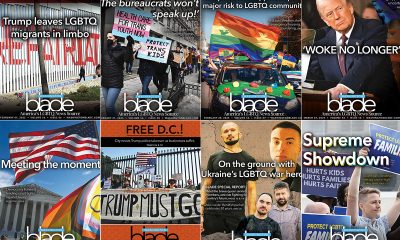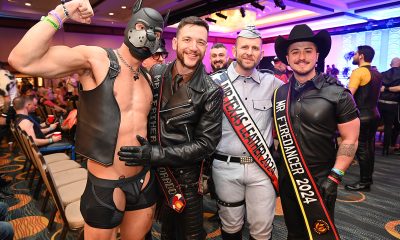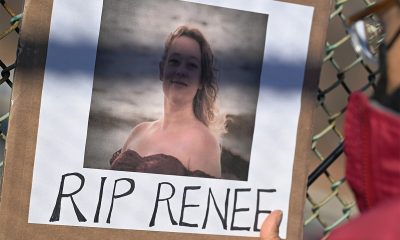a&e features
Golden Globes announces diverse slate of nominees
But is it diverse enough to quell controversy?
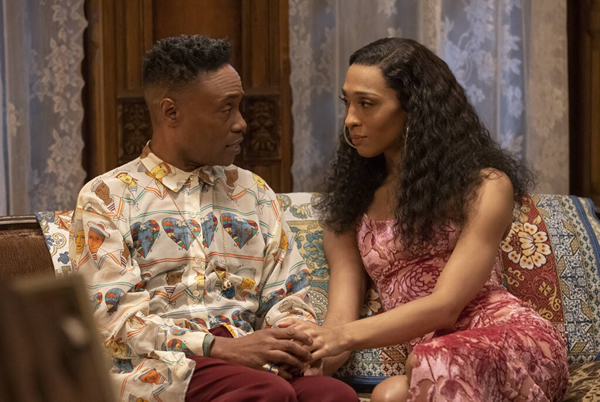
HOLLYWOOD – If any doubt remained that the Hollywood Foreign Press Association has fallen spectacularly out of favor, it was summarily erased by the fact that the sole celebrity on hand to help announce the list of nominations for its 2021 Golden Globe Awards was Snoop Dogg.
That’s not a dig against Snoop Dogg. The eminently lovable rapper is an icon who manages to float effortlessly between worlds within the entertainment industry, thanks to a reputation for enthusiastic self-parody and a proven tendency to be pretty much game for anything – and frankly, watching him read the service manual for a vintage sewing machine would likely be more entertaining than sitting through a list of award nominees being recited (with perfunctory reverence, of course) by even the most accomplished of screen thespians.
Still, the glaring absence of any representative from the industry which the HFPA exists to honor is proof that the organization is still a long way from recovering from the scandal that broke in the wake of a Los Angeles Times investigative report earlier this year, which revealed that its nearly 90-person membership included no people of color and provided damning details about its long-alleged unethical practices – including the influence over its voting process by gifts, paid travel, and other perks from studios and networks behind the potential nominees and winners.
The bombshell report, which was published mere days before the Golden Globes presentation last February, led to an embarrassing award show in which the revelation of the winners was eclipsed by the organization’s scramble to do damage control.
Leaning into a too-little-too-late show of diversity among the ceremony’s performers and presenters, and sending some of the HFPA’s high-level representatives to the podium in a desperate effort to spin the situation with a not-quite-apology for its previous shortcomings (followed by an unconvincing promise to do better), the organization seemed only to have dug itself deeper into the hole of bad publicity that threatened to put an end to the awards body’s 78-year existence, once and for all.
Proposed reforms to the structure and practices of the HFPA were announced, and were promptly dismissed by Time’s Up as “window-dressing platitudes.” Major players in the industry announced intentions to boycott the Golden Globes; more than a hundred PR firms threatened to cut off the HFPA from access to their clients; high-profile talent publicly denounced the organization, with three-time winner Tom Cruise even returning his trophies. Perhaps most disastrous of all, NBC – the network which had been home to the Golden Globes broadcast – announced it would not be airing another one until at least 2023, saying that “change of this magnitude takes time and work” and that “the HFPA needs time to do it right”.
Despite all this, the beleaguered organization declared its intention to continue with its annual awards presentation, and following months of restructuring – in which the HFPA has attempted to diversify its ranks by adding new members, rewritten its bylaws, forbidden the acceptance of gifts, restricted compensated travel, and undertaken an effort to revamp itself from bottom to top – has tenaciously clung to relevance by announcing the nominees for this year’s crop of films and television shows in an early morning press conference marked by the non-participation of any of the potential recipients of those honors.
This means, of course, that it’s time to start gearing up for another awards season in which the dramatic changes wrought by the Covid pandemic upon the entertainment industry are sure to have a still-unpredictable effect on the outcomes, and to engage in a game of “armchair quarterbacking” as we attempt to predict how the honors bestowed by other awards bodies will impact the winners’ circle for the most coveted industry prize of all: the Oscars.
Traditionally, the Golden Globes have been seen as a bellwether for Academy Award inclusion, with many of the nominees and winners going on to eventual Oscar glory – but given the current still-ongoing boycott of the HFPA by so many of the industry’s most influential power-players, it remains to be seen if that long-standing assumption will hold true this year.
With that in mind, it’s worth taking a look at the nominees – with an eye to the diversity among the choices, particularly the inclusion of LGBTQ-relevant nominees among the contenders.
For television, Black actors Billy Porter (“Pose”) and Omar Sy (“Lupin”), as well as South Korean actor Lee Jung-jae (“Squid Game”), received nominations as Best Lead Actor in a Drama Series, while the equivalent Lead Actress category included Black actress Uzo Aduba (“In Treatment”) and Black/Puerto Rican actress Michaela Jaé Rodriguez (“Pose”) – who also makes history by becoming the first transgender performer to be nominated in this category, a feat she also accomplished at the 2021 Emmys. In the Comedy division, Black actor Anthony Anderson (“Black-ish”) picked up a nod as Best Lead Actor, with Black actresses Issa Rae (“Insecure”) and Tracee Ellis Ross (“Black-ish”) included among the nominees for Best Lead Actress.
In the supporting categories (which are not divided into comedy and drama division), O Yeong-su (“Squid Game”) got a nod for Best Supporting Actor, with no nominees of color named within the Supporting Actress slate.
For performances in a Limited Series, Anthology Series, or Motion Picture Made for Television, Latino actor Oscar Isaac (“Scenes From a Marriage”) and French-Algerian actor Tahar Rahim (“The Serpent”) made the cut for Best Actor, while Black actress Cynthia Erivo (“Genius: Aretha”) was nominated for Best Actress.
The big screen acting categories also included several nominees of color. Though there were no performers of color in the running for Best Lead Actress in a Motion Picture Drama, the Lead Actor slate includes three Black actors – Mahershala Ali (“Swan Song”), Will Smith (“King Richard”), and Denzel Washington (“The Tragedy of Macbeth”) – among its contenders. In the Musical or Comedy division, Latino actor Anthony Ramos (“In the Heights”) scored a nomination for Lead Actor, with Latino/Polish newcomer Rachel Zegler (“West Side Story”) earning a nod for Lead Actress.
In the Supporting categories (which again, are not separated into Drama and Comedy divisions), Black performers Aunjanue Ellis (“King Richard”) and Ruth Negga (“Passing”) joined Black/Puerto Rican performer Ariana DeBose (“West Side Story”) on the list of Actress nominees, and while the Actor category contained no performers of color, deaf actor Troy Kotsur (“CODA”) made the cut, in a rare show of representation for people with disabilities.
When it comes to LGBTQ representation, however, the nominations fall considerably shorter. Among all the acting nominees, the only out members of the community are Porter and Rodriguez (each in their respective Lead Performance categories for “Pose”), Kristen Stewart (“Spencer”) and Lady Gaga (“House of Gucci”) for Lead Actress in a Motion Picture Drama, and Hannah Einbender (“Hacks”) for Best Performance by a Lead Actress in a Television Comedy. In addition to these, Udo Azuba (nominated for Best Lead Actress in a Television Drama for“In Treatment”), Andrew Garfield (nominated for Best Lead Actor in a Motion Picture Musical or Comedy for “tick, tick… Boom!”) and Erivo are noted for their vocal LGBTQ advocacy as allies.
While nominees Benedict Cumberbatch and Kodi Smit-McPhee (nominated for Lead and Supporting Actor, respectively, in a Motion Picture Drama for “The Power of the Dog”) play queer characters, both identify as straight in real life. The same is true for Ewan McGregor, nominated as Best Actor in a Limited Series for his star turn as the title character in “Halston”.
Finally, it’s worth mentioning that the Best Director of a Motion Picture category, long dominated exclusively by men, this year includes two women: Jane Campion (“The Power of the Dog”) and Maggie Gyllenhall (“The Lost Daughter”)
Whether or not these nominees – or any of the others, for that matter – end up following up their recognition today with nods or wins on Oscar night remains to be seen. In the meantime, we can find out who takes home the HFPA’s prizes (as well as who actually shows up to claim a prize from an organization now relegated to pariah status by most of Hollywood) on January 9, when the ceremony can be seen on the Golden Globes’ You Tube channel.
A complete list of nominations is below.
Best Television Series, Musical or Comedy
“The Great” (Hulu)
“Hacks” (HBO/HBO Max)
“Only Murders in the Building” (Hulu)
“Reservation Dogs” (FX on Hulu)
“Ted Lasso” (Apple TV Plus)
Best Performance by an Actor in a Television Series, Drama
Brian Cox (“Succession”)
Lee Jung-jae (“Squid Game”)
Billy Porter (“Pose”)
Jeremy Strong (“Succession”)
Omar Sy (“Lupin)
Best Performance by an Actress, Limited Series, Anthology Series or a Motion Picture made for Television
Jessica Chastain (“Scenes From a Marriage”)
Cynthia Erivo (“Genius: Aretha”)
Elizabeth Olsen (“WandaVision“)
Margaret Qualley (“Maid”)
Kate Winslet (“Mare of Easttown”)
Best Director, Motion Picture
Kenneth Branagh (“Belfast”)
Jane Campion (“The Power of the Dog”)
Maggie Gyllenhaal (“The Lost Daughter”)
Steven Spielberg (“West Side Story”)
Denis Villeneuve (“Dune”)
Best Performance by an Actress in a Motion Picture, Musical or Comedy
Marion Cotillard (“Annette”)
Alana Haim (“Licorice Pizza”)
Jennifer Lawrence (“Don’t Look Up”)
Emma Stone (“Cruella”)
Rachel Zegler (“West Side Story”)
Best Performance by an Actor in a Motion Picture, Drama
Mahershala Ali (“Swan Song”)
Javier Bardem (“Being the Ricardos”)
Benedict Cumberbatch (“The Power of the Dog”)
Will Smith (“King Richard”)
Denzel Washington (“The Tragedy of Macbeth”)
Best Television Series, Drama
“Lupin” (Netflix)
“The Morning Show” (Apple TV Plus)
“Pose” (FX)
“Squid Game” (Netflix)
“Succession” (HBO/HBO Max)
Best Performance by an Actress in a Television Series, Drama
Uzo Aduba (“In Treatment”)
Jennifer Aniston (“The Morning Show”)
Christine Baranski (“The Good Fight)
Elisabeth Moss (“The Handmaid’s Tale”)
Michaela Jaé Rodriguez (“Pose”)
Best Performance by an Actor, Limited Series, Anthology Series or Motion Picture made for Television
Paul Bettany (“WandaVision”)
Oscar Isaac (“Scenes From a Marriage”)
Michael Keaton (“Dopesick”)
Ewan McGregor (“Halston”)
Tahar Rahim (“The Serpent”)
Best Performance by an Actor in a Motion Picture, Musical or Comedy
Leonardo DiCaprio (“Don’t Look Up”)
Peter Dinklage (“Cyrano”)
Andrew Garfield (“Tick, Tick … Boom!”)
Cooper Hoffman (“Licorice Pizza”)
Anthony Ramos (“In the Heights”)
Best Supporting Actor – Motion Picture
Ben Affleck (“The Tender Bar”)
Jamie Dornan (“Belfast”)
Ciarán Hinds (“Belfast”)
Troy Kotsur (“CODA”)
Kodi Smit-McPhee (“The Power of the Dog”)
Best Original Score, Motion Picture
“The French Dispatch” (Searchlight Pictures) — Alexandre Desplat
“Encanto” (Walt Disney Pictures) — Germaine Franco
“The Power of the Dog” (Netflix) — Jonny Greenwood
“Parallel Mothers” (Sony Pictures Classic) — Alberto Iglesias
“Dune” (Warner Bros.) — Hans Zimmer
Best Actress in a TV Series, Musical or Comedy
Hannah Einbinder (“Hacks”)
Elle Fanning (“The Great”)
Issa Rae (“Insecure”)
Tracee Ellis Ross (“Black-ish”)
Jean Smart (“Hacks”)
Best Limited Series, Anthology Series or a Motion Picture made for Television
“Dopesick” (Hulu)
“Impeachment: American Crime Story” (FX)
“Maid” (Netflix)
“Mare of Easttown” (HBO/HBO Max)
“The Underground Railroad” (Amazon Prime Video)
Best Supporting Actor, Television
Billy Crudup (“The Morning Show”)
Kieran Culkin (“Succession”)
Mark Duplass (“The Morning Show”)
Brett Goldstein (“Ted Lasso”)
O Yeong-su (“Squid Game”)
Best Picture, Musical or Comedy
“Cyrano” (MGM)
“Don’t Look Up” (Netflix)
“Licorice Pizza” (MGM)
“Tick, Tick … Boom!” (Netflix)
“West Side Story” (20th Century Studios / Walt Disney Studios Motion Pictures)
Best Supporting Actress, Motion Picture
Caitríona Balfe (“Belfast”)
Ariana DeBose (“West Side Story”)
Kirsten Dunst (“The Power of the Dog”)
Aunjanue Ellis (“King Richard”)
Ruth Negga (“Passing”)
Best Picture, Foreign Language
“Compartment No. 6” (Sony Pictures Classics) — Finland, Russia, Germany
“Drive My Car” (Janus Films) — Japan
“The Hand of God” (Netflix) — Italy
“A Hero” (Amazon Studios) — France, Iran
“Parallel Mothers” (Sony Pictures Classics) — Spain
Best Screenplay, Motion Picture
Paul Thomas Anderson — “Licorice Pizza” (MGM/United Artists Releasing)
Kenneth Branagh — “Belfast” (Focus Features)
Jane Campion — “The Power of the Dog” (Netflix)
Adam McKay — “Don’t Look Up” (Netflix)
Aaron Sorkin — “Being the Ricardos” (Amazon Studios)
Best Performance by an Actress in a Motion Picture, Drama
Jessica Chastain (“The Eyes of Tammy Faye”)
Olivia Colman (“The Lost Daughter”)
Nicole Kidman (“Being the Ricardos”)
Lady Gaga (“House of Gucci”)
Kristen Stewart (“Spencer”)
Best Motion Picture, Drama
“Belfast” (Focus Features)
“CODA” (Apple)
“Dune” (Warner Bros.)
“King Richard” (Warner Bros.)
“The Power of the Dog” (Netflix)
Best Television Actor, Musical / Comedy Series
Anthony Anderson (“Black-ish”)
Nicholas Hoult (“The Great”)
Steve Martin (“Only Murders in the Building”)
Martin Short (“Only Murders in the Building”)
Jason Sudeikis (“Ted Lasso”)
Best Supporting Actress, Television
Jennifer Coolidge (“White Lotus”)
Kaitlyn Dever (“Dopesick”)
Andie MacDowell (“Maid”)
Sarah Snook (“Succession”)
Hannah Waddingham (“Ted Lasso”)
Best Original Song, Motion Picture
“Be Alive” from “King Richard” (Warner Bros.) — Beyoncé Knowles-Carter, Dixson
“Dos Orugitas” from “Encanto” (Walt Disney Pictures) — Lin-Manuel Miranda
“Down to Joy” from “Belfast” (Focus Features) — Van Morrison
“Here I Am (Singing My Way Home)” from “Respect” (MGM/United Artists Releasing) — Jamie Hartman, Jennifer Hudson, Carole King
“No Time to Die” from “No Time to Die” (MGM/United Artists Releasing) — Billie Eilish, Finneas O’Connell
Best Motion Picture, Animated
“Encanto” (Walt Disney Studios Motion Pictures)
“Flee” (Neon)
“Luca” (Walt Disney Studios Motion Pictures)
“My Sunny Maad” (Totem Films)
“Raya and the Last Dragon” (Walt Disney Studios)
a&e features
Visible and unapologetic: MAL brings the kink this weekend
Busy lineup includes dances, pups, super heroes, and more
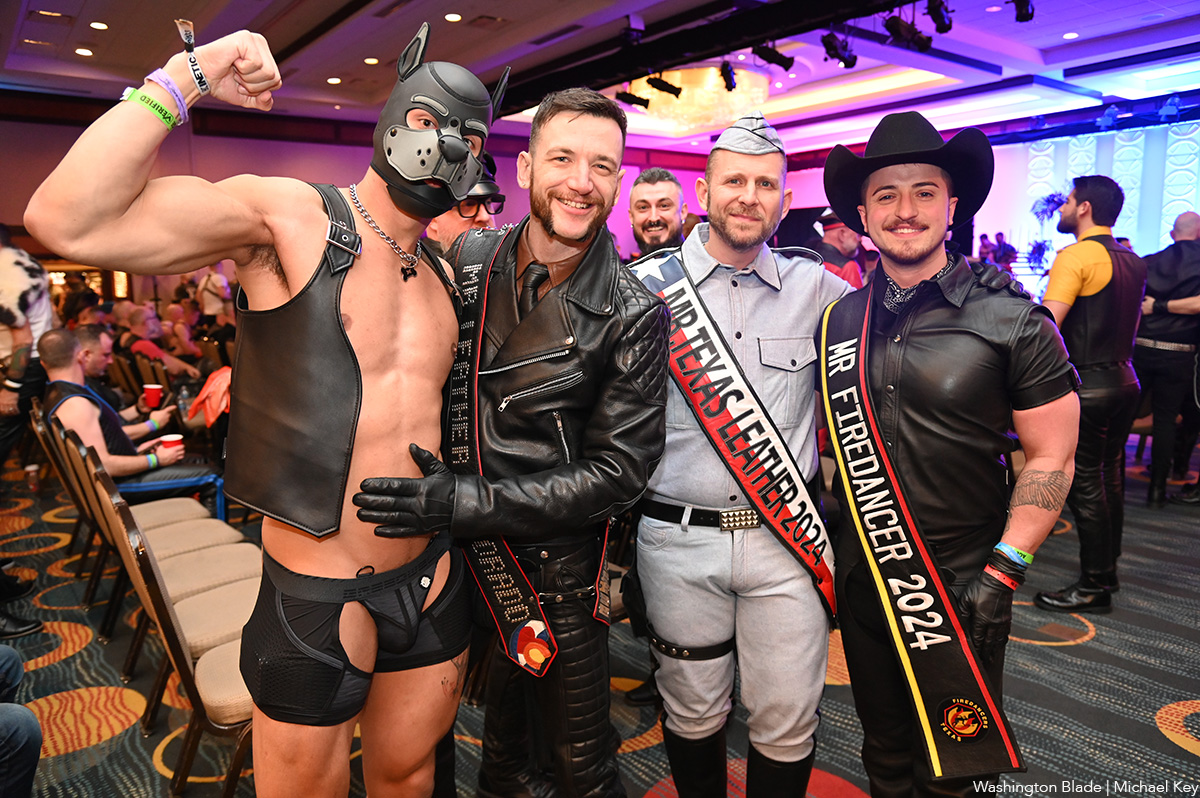
MLK Weekend in D.C. brings the annual Mid-Atlantic Leather (MAL) Weekend. Just a short walk from where Congress has been attacking queer Americans this year, MAL takes place at the Hyatt Regency Washington for several days of intrigue, excitement, leather, and kink.
The Centaur Motorcycle Club — one of several similar groups dedicated to leather in the country — has been hosting MAL in its current form for more than 40 years. Originally a small gathering of like-minded people interested in the leather lifestyle, MAL has grown to include a full four days of events, taking place onsite at the Hyatt Regency Washington (400 New Jersey Ave., N.W.). Select partner happenings take place each night, and many more non-affiliated events are scattered across the DMV in honor of and inspired by MAL.
MAL Weekend has become an internationally renowned event that celebrates fetish culture, yet it also raises funds for LGBTQ organizations, “reinforcing its legacy as both a cultural and philanthropic cornerstone of the global leather community,” according to MAL organizers.
During the day, MAL events at the Hyatt include workshops, social gatherings, shopping, and other in-person engagements for the community.
“The Hyatt underwent an extensive top to bottom renovation after last year’s event,” says Jeffrey LeGrand-Douglass, the event chair. The lobby, meeting spaces, guest rooms, and other areas have been updated, he notes, “so I am very excited for our guests to experience the new design and layout for the first time. And of course as with every year, we look forward to the contest on Sunday afternoon and seeing who will become our new Mr. MAL.”
In the evening, MAL hands the reins to partner KINETIC Presents, the D.C.-based nightlife production company. KINETIC will host four consecutive nights of high-production events that fuse cutting-edge music, immersive environments, and performance. This year, KINETIC is popping open doors to new-to-MAL venues, international collabs, play zones, and a diverse lineup.
According to KINETIC managing partner Zach Renovátes, 2026 is the most extensive MAL production to date. “The talent lineup is unreal: an all-star roster of international DJs, plus drag superstar performances at the Saturday main event,” he says.
Renovátes added that he’s “most excited about the collaborations happening all weekend — from bringing in MACHO from WE Party Madrid, to teaming up with local leather groups, to nonprofit partners, and Masc Diva [a queer nightlife collective].”
Official MAL events begin on Thursday with the Full Package/Three Day Pass Pick-Up from 5:30-8:30 p.m. at the Hyatt.
Thursday night is also the KINETIC kickoff party, called LUST. Running 10 p.m. – 3 a.m., it’s being held at District Eagle. DJ Jay Garcia holds it down on the first floor, while DJ Mitch Ferrino spins in the expansive upstairs. LUST features special performances from the performers including Serg Shepard, Arrow, Chase, and Masterpiece.
Renovátes notes that the LUST opening party at District Eagle coincides with the bar’s grand re-opening weekend. The bar will unveil its new permanent home on the renovated second floor. “it felt like the perfect place to start Mid-Atlantic Leather weekend — right in D.C.’s only dedicated home for kink communities,” he says.
After Thursday night, Friday is when daytime events begin at the Hyatt. The Exhibit Hall, on the ballroom level below the lobby, hosts upwards of 30 vendors, exhibitors, and booths with leather goods, fetish wear, clothes, toys, other accessories, providing hours of time to shop and connect with attendees and business owners. The Exhibit Hall will be open on Friday from 4-10 p.m., as well as on Saturday and Sunday afternoons.
DC Health is once again back at MAL, to provide preventative health services. In the past, DC Health has provided MPox vaccines, Doxy PEP, HIV testing, Narcan kits, and fentanyl test strips. This booth will be open on Friday 4-10 p.m.
Later, at 6 p.m., the Centaur MC is holding its welcome reception on the ballroom floor. After the Centaur’s Welcome Reception, the MIR Rubber Social is 8-11 p.m. A Recovery Meeting is scheduled at 10 p.m.
Many attendees enjoy visiting the guest room levels of the hotel. Note that to get in an elevator up to a hotel room, a staff member will check for a hotel room wristband. Non-registered guests can only access host hotel rooms if they are escorted by a registered guest with a valid wristband. Registered guests are permitted to escort only one non-registered guest at a time. Non-registered guests with a wristband who are already in the hotel before 10 p.m. may remain until midnight. However, non-registered guests without a wristband will not be admitted after registration closes.
Friday night, for the first time, KINETIC Presents is joining forces with WE Party to bring MACHO to Washington, D.C. This official MAL Friday event delivers two stages and two genres. On the UNCUT XXL stage, international Brazilian circuit superstars Erik Vilar and Anne Louise bring their signature high-energy sound. On the MACHO stage, Madrid’s Charly is joined by Chicago’s tech-house force, Karsten Sollors, for a blend of techno and tech house. UNCUT also features the XL Play Zone, a massive, immersive space exclusive to this event. The party takes place at the Berhta space from 10 p.m.-4 a.m..
“This year we’re bringing back the two-room format we debuted at WorldPride for both Friday and Saturday, so attendees can really tailor their experience — whether they’re in the mood for circuit or tech house.” says Renovátes.
Directly after Friday’s UNCUT XXL, UNDERWORLD Afters takes over District Eagle, from 3:30-8 a.m. International DJ Eliad Cohen commands the music.
Saturday, the Exhibit Hall opens earlier, at 11 a.m.. DC Health will also be back from 11 a.m. to 6 p.m.
Saturday is also time for one of the most anticipated events, the Puppy Mosh, running from 11 a.m. to 1 p.m. During the event, pup culture comes to life, when pups, handlers, and friends can enjoy an inclusive, safe pup zone. There is also a Recovery Meeting at 11 a.m., and the IML Judges Announcement takes place at noon.
The popular Super Hero Meet Up will be held 1:30 p.m. – 3 p.m., sponsored by One Magical Weekend, for cosplayers, comic enthusiasts, and their friends.
From 2-6 p.m., the Onyx Fashion Show will take place to showcase and highlight people of color in leather.
Finally, the Leather Cocktail Party – the original event of MAL – will be held 7-9 p.m. in the Ballroom. While this requires special tickets to attend, at 9 p.m. is the MAL cocktail party, which is open to wider attendees.
The last event of Saturday leaves the hotel, again a partnership with KINETIC. Kicking off at 10 p.m. and running until 4 a.m., it’s just the second time that KINETIC’s Saturday night party is an official MAL event and serves as the main weekend engagement.
Saturday night’s centerpiece is called KINK: Double Trouble. The night will feature a first-ever back-to-back set from international electronic music icons Nina Flowers and Alex Acosta on the Circuit/Tribal Stage. The other room – the Tech House Stage – curated by The Carry Nation and Rose, provides a darker, underground counterpoint, reinforcing the event’s musical depth and edge.
Beyond the DJs, KINETIC has called in the big shots for this party: “RuPaul’s Drag Race” legends Nymphia Wind and Plastique Tiara are set to headline. The party also takes place at Berhta.
Sunday, back at the hotel, there will be another Recovery Meeting at 10 a.m., and the Exhibit Hall opens again from 11 a.m.-5 p.m.
At 1 p.m., the anticipated and prestigious Mr. MAL Contest that celebrates the achievements of the leather community will be held in the Ballroom. This highly sought after title gives one man the power to become the Mid-Atlantic Leather man of the year. Sash and title winners must be (1) male, (2), a resident of North America, (3) At least 21 years of age; and (4) self-identify as gay. The first Mr. MAL was crowned in 1985. The Winner of Mr. MAL has the privilege of later competing in International Mr. Leather (IML) in Chicago on Memorial Day Weekend 2025.
From 4 p.m. to 12 a.m., MAL will hold its Game Night for the gaymers in attendance. There will also be a special screening of A24’s new film, “Pillion,” about a man who is swept off his feet when an enigmatic, impossibly handsome biker takes him on as his submissive.
Sunday closes with a community partner event produced by Masc Diva, featuring Horse Meat Disco with support from Coach Chris, at A.I. Warehouse in the Union Market district. It’s the same team that produced HMD during WorldPride at A.I. Warehouse.
Note that there are several types of passes for attendance to the hotel and parties. KINK VIP Weekend Passes include express entry, VIP areas, and enhanced amenities throughout the weekend, while MAL Full Weekend Package holders receive access to the official Sunday closing event.
At last year’s MAL events, KINETIC Presents raised more $150,000 for LGBTQ charities, and expects to match or exceed that impact in 2026.
Renovátes stated that “now more than ever, it’s important to create safe, affirming spaces for our community — but it’s just as important to be visible and unapologetic. We want to make it clear that the LGBTQ+ and leather communities aren’t going anywhere. We’ve fought too long and too hard to ever feel like we have to shrink ourselves again, no matter what the political climate looks like.”
In addition to the KINETIC events, various LGBTQ bars will hold parties celebrating the theme of the weekend. For example, Kiki, located on U Street NW, is hosting a party called KINKI, hosted by DJ Dez, on Saturday night. Sister bar Shakiki, on 9th Street NW, is hosting a party called Railed Out, a fetish-inspired party that features a play zone, on Thursday night. Flash, on U Street NW, will hold its infamous Flashy Sunday party to close out the weekend.
a&e features
Queer highlights of the 2026 Critics Choice Awards: Aunt Gladys, that ‘Heated Rivalry’ shoutout and more
Amy Madigan’s win in the supporting actress category puts her in serious contention to win the Oscar for ‘Weapons’

From Chelsea Handler shouting out Heated Rivalry in her opening monologue to Amy Madigan proving that horror performances can (and should) be taken seriously, the Critics Choice Awards provided plenty of iconic moments for queer movie fans to celebrate on the long road to Oscar night.
Handler kicked off the ceremony by recapping the biggest moments in pop culture last year, from Wicked: For Good to Sinners. She also made room to joke about the surprise hit TV sensation on everyone’s minds: “Shoutout to Heated Rivalry. Everyone loves it! Gay men love it, women love it, straight men who say they aren’t gay but work out at Equinox love it!”
The back-to-back wins for Jacob Elordi in Frankenstein and Amy Madigan in Weapons are notable, given the horror bias that awards voters typically have. Aunt Gladys instantly became a pop culture phenomenon within the LGBTQ+ community when Zach Cregger’s hit horror comedy released in August, but the thought that Madigan could be a serious awards contender for such a fun, out-there performance seemed improbable to most months ago. Now, considering the sheer amount of critics’ attention she’s received over the past month, there’s no denying she’s in the running for the Oscar.
“I really wasn’t expecting all of this because I thought people would like the movie, and I thought people would dig Gladys, but you love Gladys! I mean, it’s crazy,” Madigan said during her acceptance speech. “I get [sent] makeup tutorials and paintings. I even got one weird thing about how she’s a sex icon also, which I didn’t go too deep into that one.”
Over on the TV side, Rhea Seehorn won in the incredibly competitive best actress in a drama series category for her acclaimed performance as Carol in Pluribus, beating out the likes of Emmy winner Britt Lower for Severance, Carrie Coon for The White Lotus, and Bella Ramsey for The Last of Us. Pluribus, which was created by Breaking Bad’s showrunner Vince Gilligan, has been celebrated by audiences for its rich exploration of queer trauma and conversion therapy.
Jean Smart was Hack’s only win of the night, as Hannah Einbinder couldn’t repeat her Emmy victory in the supporting actress in a comedy series category against Janelle James, who nabbed a trophy for Abbott Elementary. Hacks lost the best comedy series award to The Studio, as it did at the Emmys in September. And in the limited series category, Erin Doherty repeated her Emmy success in supporting actress, joining in yet another Adolescence awards sweep.
As Oscar fans speculate on what these Critics Choice wins mean for future ceremonies, we have next week’s Golden Globes ceremony to look forward to on Jan. 11.
a&e features
Looking back at the 10 biggest A&E stories of 2025
‘Wicked,’ Lady Gaga’s new era, ‘Sexy’ Bailey and more

Although 2025 was a year marked by countless attacks on trans rights and political setbacks, the year also saw brilliant queer artists continuing to create art. From Cannes and Sundance Award winners now vying for Oscar consideration to pop icons entering new stages of their careers, queer people persevered to tell their stories through different media.
With the state of the world so uncertain, perhaps there’s no more vital time to celebrate our wins, as seen through some of this year’s top pop culture moments. While there’s no collection of 10 stories that fully encompass “the most important” news, here are some events that got the gays going:
10. ‘Mysterious Gaze of the Flamingo’ wins big at Cannes

The Cannes Film Festival has become a crucial start for films hoping to make their way to the Oscars, and first-time director Diego Céspedes won the top Un Certain Regard prize for his intimate western “The Mysterious Gaze of the Flamingo.” The film is set in the ‘80s and is intended as an allegory for the AIDS epidemic. Seeing a film that unpacks vital queer history win one of the most coveted awards at Cannes has been a huge point of pride in the independent filmmaking community.
Since the film bowed at Cannes, it has been selected as Chile’s Oscar entry in the Best International Feature race. Speaking with The Blade during the film’s AFI Fest run in October, Céspedes said: At first, I was kind of scared to have this campaign position in the times that we’re living [in] here. But at the same time, I think the Oscars mean a huge platform — a huge platform for art and politics.”
9. ‘The Last of Us’ returns for an even gayer season 2
While the first season of The Last of Us gave us one of TV’s most heartbreaking queer love stories in the episode “Long, Long Time,” Season 2 doubled down on its commitment to queer storytelling with the blossoming relationship between Ellie (Bella Ramsey) and Dina (Isabela Merced). The show expanded on the pair’s relationship in the original video game, making it perhaps the central dynamic to the entire season. That unfortunately came with more homophobic backlash on the internet, but those who checked out all the episodes saw a tender relationship form amid the show’s post-apocalyptic, often violent backdrop. For their performance, Ramsey was once again nominated for an Emmy, but Merced deserved just as much awards attention.
8. ‘Emilia Pérez’ sparks controversy
Jacques Audiard’s genre-bending trans musical “Emilia Pérez” proved to be an awards season juggernaut this time last year, winning the Golden Globe for Best Musical/Comedy. But when the lead star Karla Sofia Gascón’s racist, sexist, and homophobic old tweets resurfaced, the film’s Oscar campaign became a tough sell, especially after Netflix had tried so hard to sell Emilia Pérez as the “progressive” film to vote for. Mind you, the film had already received significant backlash from LGBTQ+ audiences and the Mexican community for its stereotypical and reductive portrayals, but the Gascón controversy made what was originally just social media backlash impossible to ignore. The only person who seemed to come out of the whole debacle unscathed was Zoe Saldaña, who won the Oscar for Best Supporting Actress over Ariana Grande.
7. ‘Sorry, Baby’ establishes Eva Victor as major talent
Back in January at the Sundance Film Festival, Eva Victor (known by many for her brand of sketch comedy) premiered their directorial debut “Sorry, Baby” to rave reviews, even winning the Waldo Salt Screening Award. Victor shadowed Jane Schoenbrun on the set of “I Saw the TV Glow,” and seeing Victor come into their own and establish such a strong voice immediately made them one of independent cinema’s most exciting new voices. A memorable scene in the film sees the main character, Agnes (played by Victor), struggling to check a box for male or female, just one example of how naturally queerness is woven into the fabric of the story.
Most recently, Victor was nominated for a Golden Globe for her performance in the film, and she’s represented in a category alongside Jennifer Lawrence (“Die My Love”), Jessie Buckley (“Hamnet”), Julia Roberts (“After the Hunt”), Renate Reinsve (“Sentimental Value”) and Tessa Thompson (“Hedda”). The film also received four Independent Spirit Award nominations overall.
6. Paul Reubens comes out in posthumous doc

While Paul Reubens never publicly came out as gay before passing away in 2023, the two-part documentary “Pee-wee as Himself” premiered back in May on HBO Max, giving the legendary comedian a chance to posthumously open up to the world. Directed by Matt Wolf, the documentary explores how Reubens found his alter ego Pee-Wee Herman and why he kept his private life private.
The documentary won an Emmy in the Outstanding Documentary or Nonfiction Special category and remains one of the most critically acclaimed titles of the year with a 100% Rotten Tomatoes score. Also worth noting, the National Geographic documentary Sally told the posthumous coming out story of Sally Ride through the help of her long-time partner, Tam O’Shaughnessy.
5. Lady Gaga releases ‘Mayhem’
Lady Gaga entered a new phase of her musical career with the release of Mayhem, her seventh album to date. From the frenzy-inducing pop hit Abracadabra to the memorable Bruno Mars duet featured on “Die With a Smile,” seeing Gaga return to her roots and make an album for the most die-hard of fans was especially rewarding after the underwhelming film releases of “House of Gucci” and “Joker: Folie à Deux.” Gaga has been touring with The Mayhem Ball since July, her first arena tour since 2018. She even extended her tour into 2026 with more North American dates, so the party isn’t stopping anytime soon. And Gaga is even set to make an appearance next May in “The Devil Wears Prada 2.”
4. Cynthia Erivo, Ariana Grande perform at the Oscars

While “Wicked: For Good” didn’t quite reach the heights of the first film, we will forever have Cynthia Erivo and Ariana Grande’s breathtaking live performance that opened the 97th Academy Awards. The pair sang a rendition of “Over the Rainbow,” “Home,” and “Defying Gravity,” paying proper homage to the original 1939 “Wizard of Oz.” Even non-Wicked fans can’t deny how magical and brilliantly staged this performance was. With both Erivo and Grande up for acting Oscars last year, they’re hoping to repeat success and make history with consecutive nominations. Either way, let’s hope there’s another live performance in the making, especially with two new original songs (The Girl in the Bubble and No Place Like Home) in the mix.
3. Indya Moore speaks out against Ryan Murphy
Indya Moore has consistently used social media as a platform for activism, and in September, posted a 30-minute Instagram live speaking out against “Pose” co-creator Ryan Murphy. Moore claimed that Murphy wasn’t being a true activist for trans people. “Ryan Murphy, we need you to do more. You need to address the racism, the violence, and the targeting of people on your productions, Ryan Murphy. You do need to make sure trans people are paid equally. Yes, Janet did the right thing,” Moore said. Murphy was also back in the headlines this year for the critically panned “All’s Fair” and the controversial “Monster: The Ed Gein Story” starring Laurie Metcalf and Charlie Hunnam.
2. Cole Escola wins Tony for Best Leading Actor
Few pop culture moments this year brought us together more than Cole Escola winning a Tony award for “Oh, Mary!” the Broadway show they created, wrote and starred in (we love a triple threat!) Escola made history by becoming the first nonbinary person to win a Tony in the leading actor category, and seeing them excitedly rush to the stage wearing a Bernadette Peters-inspired gown instantly became a viral social media moment.
The cherry on top of Escola’s major moment is the recent news that they are writing a Miss Piggy movie with Jennifer Lawrence and Emma Stone producing — news that also broke the internet for the better. We cannot wait!
1. Jonathan Bailey makes gay history as ‘Sexiest Man Alive’

The same year as his on-screen roles in blockbusters “Jurassic World Rebirth” and “Wicked: For Good,” Jonathan Bailey made history as the first openly gay man to be named People magazine’s “Sexiest Man Alive.” The fact that it took 40 years for an openly gay man to earn the title is a signifier of how far we still have to go with queer representation, and seeing Bailey celebrated is just one small step in the right direction.
“There’s so many people that want to do brilliant stuff who feel like they can’t,” he told PEOPLE, “and I know the LGBT sector is under immense threat at the moment. So it’s been amazing to meet people who have the expertise and see potential that I could have only dreamed of.” In 2024, Bailey founded the charity titled The Shameless Fund, which raises money for LGBTQ+ organizations.



